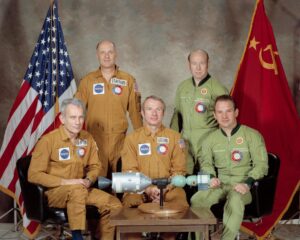






The Apollo-Soyuz Test Project (ASTP) was a historic mission that marked the first international human spaceflight. It took place in July 1975 and symbolized a thaw in the Cold War tensions between the United States and the Soviet Union. The project involved the docking of an American Apollo spacecraft with a Soviet Soyuz spacecraft, enabling crews from both nations to work together in space.
Key Aspects of Cooperation:
-
- Political Motivation:
-
- The ASTP was a product of détente, a period of improved relations between the US and the USSR during the 1970s. Both superpowers saw the project as a way to showcase their ability to cooperate peacefully and reduce the risk of accidental nuclear war.
-
- Political Motivation:
-
- Technical Challenges and Solutions:
-
- Docking Mechanism: One of the main technical challenges was developing a compatible docking system. Engineers from both countries designed the Docking Module, which acted as an airlock and docking adapter to connect the Apollo and Soyuz spacecraft.
-
- Language Barriers: To overcome language barriers, both American astronauts and Soviet cosmonauts learned basic phrases in each other’s languages and used a translation book.
-
- Life Support Systems: The teams had to ensure that life support systems were compatible to maintain the health and safety of the crews once docked.
-
- Technical Challenges and Solutions:
-
- Mission Objectives:
-
- The primary objective was to test the compatibility of rendezvous and docking systems for American and Soviet spacecraft.
-
- The crews conducted joint scientific experiments and exchanged commemorative items as symbols of their cooperation.
-
- Mission Objectives:
-
- Training and Joint Simulations:
-
- Crews from both countries underwent joint training sessions, including simulations of docking procedures and emergency protocols.
-
- This training took place both in the United States and the Soviet Union, fostering mutual understanding and teamwork.
-
- Training and Joint Simulations:
-
- Public and Scientific Impact:
-
- The mission was widely publicized and received positive attention globally as a symbol of peace and international cooperation.
-
- Scientifically, the mission provided valuable data on international spaceflight operations and set the stage for future collaborations, such as the Shuttle-Mir program and the International Space Station (ISS).
-
- Public and Scientific Impact:
Mission Summary:
-
- Launch: The Soyuz 19 spacecraft launched from the Baikonur Cosmodrome on July 15, 1975, followed by the Apollo spacecraft launched from Kennedy Space Center on the same day.
-
- Docking: The two spacecraft docked on July 17, 1975, and remained connected for two days.
-
- Activities: During their time docked, the crews conducted joint experiments, shared meals, and held a televised conference.
-
- Undocking and Return: The spacecraft undocked on July 19, 1975, and both crews returned safely to Earth in their respective spacecraft.
The Apollo-Soyuz Test Project laid the groundwork for future international collaborations in space exploration. It demonstrated that even during periods of political tension, scientific and technical cooperation could lead to significant achievements.



